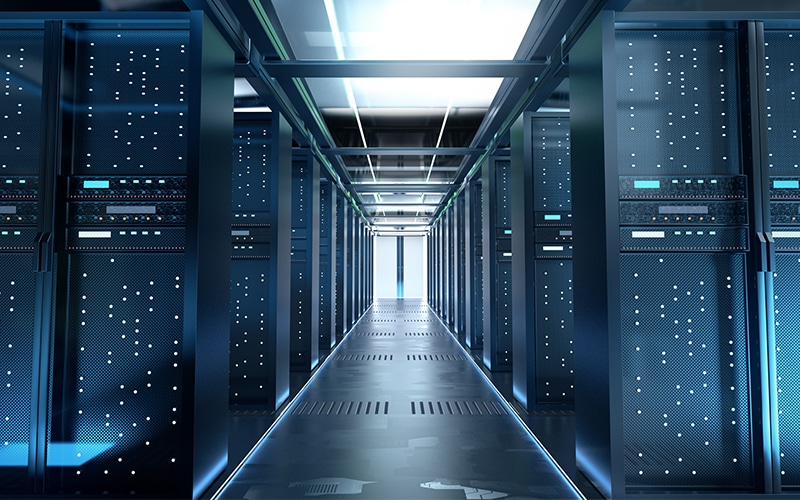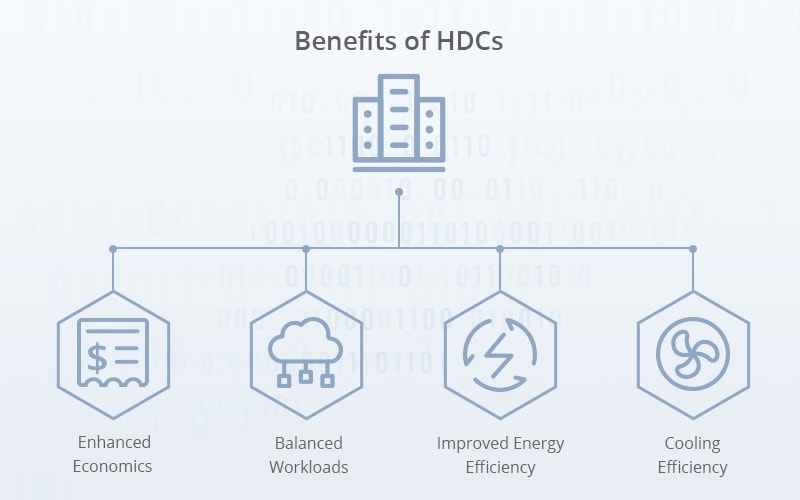What Are Hyperscale Data Centers and How Do They Work?
Ever wondered how big technology companies such as Amazon and Google continue to develop new applications by the minute for billions of users and run them with rarely any downtime? Some of the technologies launched by these companies have become integral to our day-to-day lives. But this only means increased power to fuel these applications.
If you’re wondering how these businesses can expand their global presence by continuously existing in the cloud, the answer lies with “hyperscale data centers”.
What are Hyperscale Data Centers and What Companies Use Them?
For those vaguely familiar with the term, hyperscale data centers are enormous mission-critical facilities that can support robust and scalable applications. These unique data centers are often linked to companies that need to work with big data, such as Google, Amazon, Facebook, IBM, Apple, Baidu and Microsoft (GAFAM).
Conventional enterprise data centers refer to spaces or buildings that house business IT infrastructure: equipment and servers. Companies typically use these resources to run their own operations, and can also lease them to other entities. However, hyperscale data centers easily dwarf them in performance, capacity and scalability.

The resulting size and increased computing capacity allow them to outperform conventional facilities easily. The volume of data and storage capacity handled by hyperscale facilities far exceeds its enterprise counterpart. According to a survey, most hyperscale companies expect a connection rate of at least 40 GigaBytes per second or faster. They comprise 5000+ servers with an area in excess of 10,000 square feet.
At the same time, a hyperscale data center must accommodate companies’ increasing demand for scalability at varying magnitudes. These data centers must scale up or down vertically or scale out horizontally to manage the load on the servers. Companies may require hyperscale data centers to increase their computing power, add more machines or scale out to edge computing.
Technological giants such as Yahoo, Facebook, Microsoft, Apple, Google, Amazon, and IBM are responsible for operating around half of the hyperscale data centers worldwide. Switch also operates massive hyperscale data centers but mostly rents them out to large corporations in need.
Inside a Hyperscale Data Center
Space is one of the most crucial factors when creating a hyperscale data center. This is because hyperscale data centers require vast space. One of Microsoft’s 45 hyperscale data centers located at Quincy,WA houses around 24,000 miles of network cable. For perspective, the length almost mirrors the total circumference of the Earth!
Another Hyperscale data center operated by Microsoft HDC, located in Singapore, may not be physically the biggest place but houses enough concrete to build a sidewalk connecting London to Paris, which makes up some 215 miles in length. This should give you a good idea of the complexity and magnitude entailed by a data center to be termed “hyperscale.”
What’s interesting to note is that despite the complexity and magnitude, a data center does not typically require a sizable full-time staff. This is because much of the technology employed across various disciplines is automated. It is possible to have the number of security staff exceed that of the IT and computing staff at Hyperscale.
Largest Hyperscale Data Centers
According to International Data Corporation, for a data center to be hyperscale, it must exceed at least 5000 servers with around 10,000 square feet of physical space. A typical hyperscale data center can use almost the same amount of electricity as a small town.
The largest data center campus belongs to Switch called ‘The Citadel’ and is located in Tahoe Reno, NV. Switch operates this Tier-4 data center as a colocation facility and leases space to other corporations such as Intel, Boeing, Qualcomm, Bungie, and McAfee. This 7.2 million square-feet facility runs on 100% renewable energy, costing only 5 cents/kWh. It provides super-fast connectivity to hi-tech population zones like Los Angeles and San Francisco. Switch also owns another facility in Las Vegas, NV, called the SuperNAP, occupying 3.5 million square feet of space.
Range International Information Group hyperscale data center in Langfang, Hebei, China spreads across 6.3 million square-feet. This facility is a testament to China’s technological prowess. IBM provides the design technology, business solutions and several other services.
DFT hyperscale data center owned by DuPont Fabros Technology is located in Ashburn, Virginia. It spans across 1.6 million square feet of space and has seven different data center buildings.
Benefits of Hyperscale Data Centers
With all of the complexity of magnitude and computing that an HDC entails, it does offer attractive solutions that are imminent for large enterprises. Most of these resolve challenges that come with storing information in bulk. Here are various ways HDCs benefit the client businesses.

Enhanced Economics
Economy of scale is the obvious benefit of any hyperscale data center. With so much computing at their disposal, HDC service providers can engage in pricing & service agreements unthinkable for smaller data centers.
Balanced Workloads
Hyperscale data centers effectively distribute workload across multiple servers to avoid overheating a single server. This is important because an overheated server can also damage nearby servers setting up an unwanted chain reaction.
Improved Energy Efficiency
Although hyperscale data centers consume huge amounts of energy, overall they are more energy efficient. They also allow tenants to rent space in kilowatts which is more effective than renting space in racks or square footage. HDCs do this because they use a set number of kilowatts while allocating power.
Cooling Efficiency
Cooling can be the single most significant operational expense for most businesses. With hyperscale, companies can effectively reduce the cooling cost and focus their energies on the servers that perform much of the high-intensity computing work. A hyperscale facility will provide the necessary cooling by recycling the heat that flows only in one direction.
To learn more about how hyperscale data centers are transforming the world of IT, you can read Eight Ways Hyperscale Data Centers are Transforming the World of IT.
How to Hyperscale
Below are some of the most common hyperscale attributes found across all data centers in the industry. To hyperscale effectively, your company must work on the following foundations.
High-Density Server Racks
Well-designed racks form the basis of a fully functioning hyperscale data center. Since companies typically use their hardware in an HDC, they can custom design their racks to meet their needs. The hyperscale demand in recent years has led to the usage of a 48U rack space that outpaces a 42U counterpart making the former the new industry standard.
The Elevated Level of Cooling
Equipping the space with such power-intensive racks means there must also be top-notch cooling. Most data centers employ an HVAC system that directs cold air from under the floor to cool aisles to meet this requirement. At the same time, the hot aisles exhaust out the hot air keeping the temperature under control.
Lots of Power
Data centers can easily consume power that would be enough for a small city. For example, one data center in Virginia used up 1 gigawatt of power. This figure can easily support consumption for around 700,000 homes. Since HDCs are highly energy-intensive, they must be built in areas with cheap electricity.
Security and Space
Security is a logical concern with so much space and power at stake. Data Centers built in remote regions are naturally protected against potential thieves. But HDCs must also be fully equipped to protect themselves from cyberattacks since they contain bulks of customer information of a sensitive nature.
Managing Hyperscale Computing Data
Managing a hyperscale data center requires making up-to-date modifications and ensuring scalability. There are two ways to scale for an HDC. Scaling up is a vertical approach to help data centers increase computer power. This is achieved by directly adding power to the existing machines.
Alternatively, an HDC can “scale out” where it increases its computing power horizontally, i.e., by adding new computing machines and basically branching out the equipment. To effectively manage a hyperscale data center, companies must look after the financial power and revenue resources, the physical infrastructure, and the distribution of scalability tasks.
Pandemic Fuels Record Growth of Hyperscale Data Centers
David Barnet, Director at Americas Research, has observed the impact of the pandemic on the increasing demand for hyperscale data centers. The physical disruption brought about by the pandemic put an unprecedented strain on data centers to supply networking resources for the tech-driven world. This led to an increase in demand and investment in a data center.
According to data posted by the Synergy Research Group, the total number of data centers operated by hyperscale facilities has doubled since 2016. While the end of 2020 saw an increase of 59 more data centers globally.
Hyperscale is a concept that challenges the expanses of the mind. It is a concept that is as big to grasp as it is futuristic. It is precisely this quality of a hyperscale data center that has allowed it to support technological tycoons like Amazon, eBay, and Microsoft.
You might be interested in
Email Address

-
PoE vs PoE+ vs PoE++ Switch: How to Choose?
Mar 16, 2023
















